Over the years I have had the pleasure of introducing many a keen angler to the sport of kayak fishing, helping them to get their head around handling the kayak, working with the wind and tides, anchoring techniques, using lures and most importantly, having a plan for the session.
Recently, my cousin Alex has been getting out in the kayak a bit and he has started to crack the flathead code, so we planned a session chasing flathead on the second half of the run-out tide. More importantly, we planned to explore the higher stages of the tide where fish can be harder to come by.
The plan was to launch on the last hour of run-in and hitch a ride with the incoming tide to our first spot, where we would target a section of flats on the first couple of hours of run-out. From there we would travel across the tide and down current to work an awesome looking flathead drain that I had made note of the day before. We would then wrap things up by drifting with the last two hours of the run-out, positioning the kayak a cast distance from the bank and hopping plastics down the drop off.
We had made our plan based around the tide and involving three different types of environments and structure, all of which would potentially hold fish and in turn maximise our chances of catching fish as at least one area should fire.
I speak to plenty of anglers who struggle to catch fish when the tides are high and the fish spread out through the system, so I made a point of talking to Alex about what I look for when I’m fishing the flats. Many rivers, creeks, estuaries and other systems are loaded with banks and flats that are completely dry at low tide, and flood during the incoming tide.
The rising water allows fish to access the crabs, yabbies, pipis, cockles and other food items that call these areas home, along with prawns and baitfish seeking safety in the shallower water. The feeding frenzy can be spectacular at times!
The water was crystal clear thanks to the westerly winds, and this assisted with breaking down the flat. On the up current end of the flat, we had a small patch of rock and a sand bank, both of which created visible eddies and we could see bait flicking and the occasional fish feeding. Slightly down current, we located some depressions in the flat where the water dropped a few feet, and I even noticed a school of undersized bream holding in one depression. From here, the flat was a mix of sand, rubble and broken weed beds.
I opted to drift the flat and investigate further, while Alex deployed his anchor, positioning the kayak within casting distance of the eddies and on the edge of one of the depressions. Both of these techniques are effective. I was covering ground and looking for fish, structure and bait movement, while Alex was positioned near the prime structure on the flat waiting for schools of fish travelling through with the tide.
My initial thoughts were that bream would be the target species, however after two hops of the plastic and a bite-off, I suspected that tailor were on the flat harassing schools of bait. If you are hopping plastics for bream and flathead and a bite off occurs, try speeding up your retrieve a little, with a continual wind and plenty of twitches. This will often see fish hooked in the jaw hinge and front of the mouth, rather than taking the plastic deeper and biting you off.
Fish on! I was soon unhooking a tailor, followed by another, and then three in three casts! Although they weren’t big fish, they were still great fun from the yak, especially on light spin gear. Over the next couple of hours we landed 23 tailor, two flathead and a bream. The lure of choice was a 2.5”paddle-tail rigged on a 1/4oz 1/0 finesse jighead.
When the fishing slowed we simply moved to a different section of the flat in search of bait and actively feeding fish. As the water level changes on the flats, the bait and fish will move, so if it slows down, try a series of short moves until you find more active water.
As the water level dropped on the flat, we knew that bait would be funnelling off the flats via the drains that run into deeper water. It was time to paddle over to the large drain or blind gutter that I had made note of the previous day.
This drain was perfect, with a sandy bottom and weed edges on each side. The weed edges ensure that there will be baitfish, prawns and other food around, while the sandy bottom makes it easy for flathead to move into the drain and bury themselves ready for ambush!
If the bottom was weedier, I would have switched to a SnakelockZ weedless jighead and 3” paddl-tail, however I stuck with the rig I had used on the flats. A sounder makes finding the drains simple, however even without a sounder you can use quality polarised sunnies to separate the dark water covering weed with the lighter coloured water covering sand.
Often there is minimal current running out of these drains and you can start at the mouth, cast up the drain and hop your plastic back to the yak, slowly working up the entire length of the drain, with a few paddle or pedal strokes followed by a few casts. If there is more current, it’s worth anchoring and working a section thoroughly before moving further into the drain and anchoring again. Often these blind gutters are wide enough that you and your kayak fishing mate can fish side by side and each work one side of the gutter.
One point that Alex made is that he is understanding that the plastic doesn’t always need to be moving, and this is probably the main mistake that anglers make when fishing plastics, retrieving them too quickly. Don’t be afraid to mix up your retrieve and slow things down, or pause the lure on the bottom for a few seconds until you find what the fish want. It’s amazing how often a few quick winds, a long pause, an aggressive hop or series of subtle shakes of the rod tip will switch on the bite and it can often encourage the bite of a different species to the main target.
I hopped my little paddle-tail a couple of times, paused, went to hop the plastic again and crunch! The headshakes and initial run signalled to me that this was a quality flathead and I let the rod and drag do the work, taking it easy on the big girl, as I knew I was only connected with a 1/0 finesse jighead and 10lb leader. After a few good runs and one sighting that confirmed it was a nice flatty, I slid the net under the fish, fired off an uncontrolled fist pump and called Alex over to grab a couple of photos.
Part of me wished that Alex had hooked this one, but at the same time, flathead over mid-sixties aren’t commonly encountered in my local waters and I was over the moon to lift this one into the kayak.
I keep a few flathead for a feed, however anything over 60cm is handled with care and released to make more flathead. This one measured in at 71cm, and I soon had it back in the water attached to my lip grips while I readied the camera for a photo.
A few photos and we decided to commence our drift along the main channel edge and back to our launch point.
When fishing the channel edge, it’s all about covering ground, throwing plenty of casts and keeping an eye out for key structure that might hold fish, such as points, drains, logs, rubble, crab pots, eddies and patches of sand amongst broken weed. Fish will often school, so if you land one, it can be worth retracing your steps.
We cast to the edge of the weed beds, or into the shallows, across or slightly ahead of the drift if the current is stronger and hop the plastic down the drop off and into the channel. It didn’t take long before we came across a school of yellowtail pike, and it was visual fishing, watching them chase down and eat a plastic in the clear water, even coming out of the water on several occasions as we lifted the lure from the water. They’re not as large as the southern snook, but these oily fish are still excellent bait, and great tasting when cooked in a smoker, and we kept about twenty to hopefully turn into a mud crab or two.
Alex gave me a touch up on the drift home, landing five flathead to my three and I was stoked to see him nailing a few. This bank often produces much higher numbers, but we went into this session knowing that the tides weren’t quite right, so we were still happy for the action we had encountered.
It’s worth making note of the date, tide, moon phase, wind and temperature when you do have successful sessions in particular areas or on particular species, as it’s amazing how often these same conditions will produce similar results – even years later!
So overall, we had a pretty successful day, and weused the tides to carry us to our spots and home again. We fished some different structure, landed a few different species and solved the problems of the world on a glassy day, while drifting around with an awesome backdrop.
Alex took a flathead and five tailor home to his family, and I had a flathead for dinner, yellowtail pike for the crab pots and the photos and memories of a cracker flathead.
So it might be time for you to grab a mate, check the tides and conditions and plan your own adventure.
Reads: 1959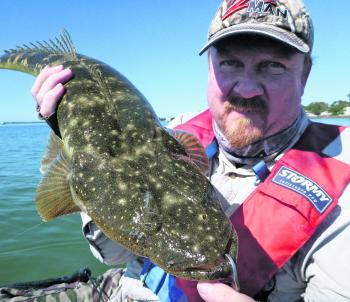
A falling tide, a blind gutter and a planned approach resulted in this quality flathead.
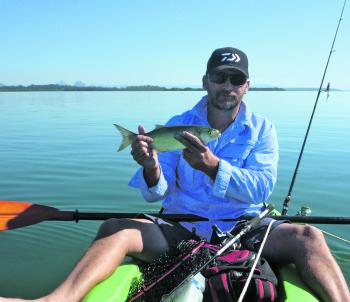
Alex with one of a couple of dozen tailor for the session.
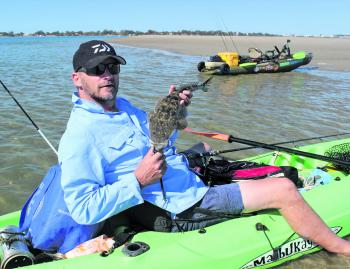
This was one of several flathead from a low tide channel edge, which the author made a plan to fish before the session.
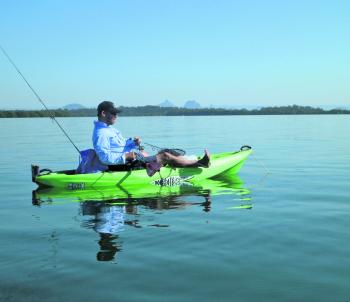
Sometimes it's not even about the fishing. Alex at anchor enjoying the glassy conditions.
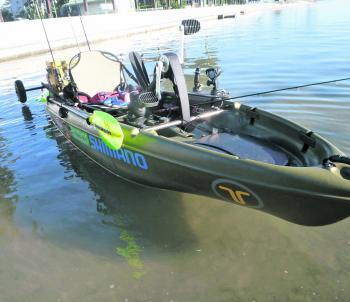
Rigged and ready for kayak luring session.
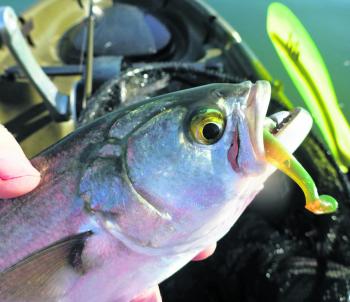
The 10X Tough ZMan 2.5” Slim SwimZ are the go-to for toothies like this tailor.
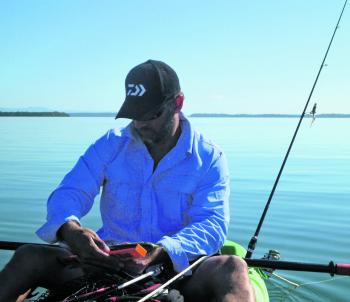
Don’t forget your fish measure and an understanding of local rules and regulations.
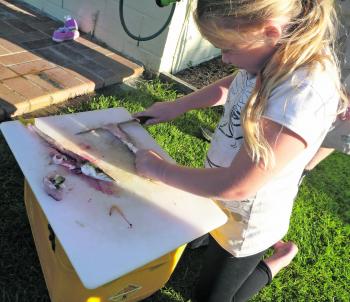
Yellowtail pike are great bait or cooked in the smoker. Ruby enjoyed learning to fillet fish.




